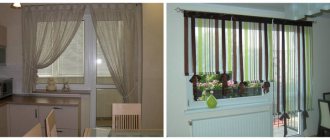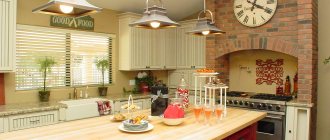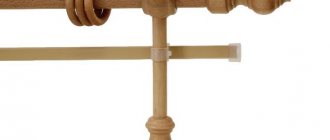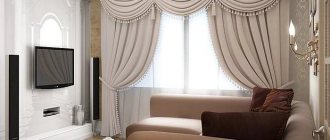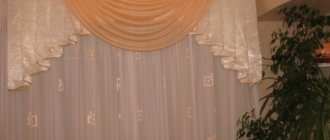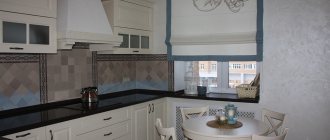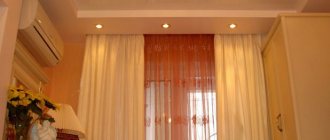To give the kitchen maximum practicality and unsurpassed beauty, you need to spend a lot of time and effort. The kitchen is the most complex room in the apartment in design terms. This is because kitchens in modern domestic apartments cannot “boast” of their dimensions, and all the necessary household appliances literally “devour” vital space.
And kitchen windows are no exception! Even an incorrectly selected cornice for the kitchen or an ordinary curtain can take away precious space, light and comfort from the room. With the help of our tips and recommendations, this will not happen!
Window cornices
How to take measurements correctly?
Before purchasing the cornice you like, you first need to measure the window opening so as not to make a mistake with the choice of design. To calculate the size of the cornice there is the following formula:
- The classic length of the cornice should be equal to the length of the window with an addition of 25-40 cm.
- The size of the cornice inside the window must fit clearly into the opening.
- Subtract the thickness of the fasteners corresponding to the cornice from the width between the two walls.
- With the help of a certain length of the cornice, you can divert attention from some of the shortcomings of the window opening. For example, a long cornice can transform a window that is too narrow, and vice versa.
We cut down the cornice in the kitchen ourselves
First, you need to understand that sawing down a cornice is not so easy and quick. And without the appropriate tool, you are unlikely to succeed. Many kitchen furniture assemblers refuse this service and offer customers to do everything themselves. And not because they are just lazy or don’t want to waste their time. In some cases, it is simply not possible to cut down a cornice at home.
For example, a miter saw takes a cut of 50-70 mm. And the cornice itself is 80-90 mm. Logically, the blade from the miter saw simply won’t cut through it. But there is, of course, the option of a miter saw with a moving carriage. But then the cornice will be cut in a lying position. That is, the cornice is placed on the bed of the circular saw, but not placed. And the angle of the cut is no longer set on the bed, but on the head of the saw itself.
To begin installing the cornice, measure the width of the corner element of the kitchen cabinet. (You must start cutting from the corner in different directions). Usually this size is 400 mm. But in Leroy Merlin kitchens this size is 330 mm. We will give an example with Leroy kitchens.
The known size is 330 mm (this size is only available in Leroy Merlin kitchens). Take a miter saw. We set an angle of 90 degrees on it and saw off the workpiece approximately 400-430 mm. At a right angle. This size must be taken with a margin to adjust the corners.
The workpiece is ready in size 430 mm. Next, you will need to adjust two corners. The size of the corner on the corner element is 22.5 degrees. We set the angle on the trim to 22.5 degrees. And we make two cuts from different sides. The cutting angle should be external. Be careful.
Types of curtain rods for the kitchen
If you have not yet decided which design you want to purchase, pay attention to the following types:
Stained glass
These types of structures are made of plastic or metal. They are fastened with hooks or self-tapping screws. Often these materials are rectangular or round in shape, and are attached directly to the window.
They are small in size, so hourglass-shaped curtains are ideal for such mountings. This cornice is used in a classic interior or in Provence style.
String
String mechanisms are made of metal and attached directly to the wall or ceiling. Such structures consist of a thin steel cable up to 9 mm long with two small metal fasteners.
String curtain rods are very convenient to use, and besides this, their main advantage is their versatility for all room styles.
Decorative
The decorative type of cornice is a rail structure with a baguette made of natural wood or artificial material that imitates this material. The wood is accompanied by various decorations, such as carvings or gilding patterns.
Electric cornice
Electric curtain rods are made mainly of metal or plastic. You can attach the electric curtain rod to the wall or the ceiling itself.
It is a material with hooks to which a wire is connected, allowing you to control the curtains at a distance using a remote control or manually.
You can also control the cornice using personal gadgets, and the cornice itself is flexible enough that it can be used for window openings of non-standard shape.
Round (rod)
Rod structures are made from different materials, but mostly wood is used as a basis. This type can be attached to walls or ceilings. It is a round tube with a diameter of 1.5-3 cm.
Having given preference to this particular cornice, it is especially important to correctly measure all the parameters of the window opening.
To successfully purchase the material, you can purchase the design in a special store, where they will cut out the cornice of the required length for you, buy a folding rod and adjust or cut it yourself, or purchase two small cornices and connect them to each other using a connector.
Polozkovy
A plastic or metal runner cornice can be attached to the ceiling or wall. Externally, this design is similar to an improved profile cornice, into which sections with an entire rail system are built.
May include a baguette made of material that imitates wood or any other material. The advantage of choosing this type is a wide range of colors and styles, which allows it to be used for any interior.
Flexible
The curtain mount is made of plastic or aluminum, and is attached in the same way as the previous types. It is a bendable material that is attached using special hooks. The ability of the structure to bend in different directions allows it to be used for unusual window openings.
Selecting a cornice for curtains
First, decide on the type of curtains. In accordance with them, a holder of one design or another is purchased. Curtains for the kitchen must meet certain requirements:
- Practicality: does not absorb fat and soot, is easy to wash, does not support combustion.
- Fits into the overall design of the room and matches the style of the kitchen set and household appliances.
- Adjust the amount of sunlight, move apart easily.
- Provide access to windows and vents, as the kitchen is often ventilated.
The most practical are blinds and Roman shades up to the length of the window sill. They perfectly protect from the summer sun, are easy to lift if necessary and take up little space. For them, cornices of the appropriate design are chosen. This cornice is mounted on the ceiling, window opening or directly on the window frame. If the opening width is large, it is better to use several strips of curtains.
Japanese curtains are also convenient to use in the kitchen and look beautiful. They are made from small strips of linen, silk, cotton fabrics or bamboo. They are mounted on an aluminum profile, the width of which is 60 cm.
Another modern option for kitchen window design is roller blinds. They are mounted on a special cornice and can be equipped with an electric drive. Such designs are used in the “smart home” system.
Related article: Do-it-yourself toilet cistern repair
Complex curtains with a lambrequin will require a double or triple curtain rod, while Austrian, French and Italian curtains are hung on a special holder.
Note: curtain rods with lambrequins are hung right up to the ceiling to make it convenient to open and close the window sashes.
Types of cornice fastening
Among the types of fastening of cornices there are:
- Wall-mounted.
- Ceiling.
Wall cornices are attached to the wall above the window, and the ceiling cornice in the kitchen is therefore attached to the ceiling. All possible types of curtain rods are suitable for wall-mounted curtain rods, while ceiling curtain rods only require string and rail curtains.
Installation of cornice
After taking measurements of the room and purchasing the necessary curtain rods, you can proceed directly to attaching it. Next, we will describe options for installing cornices on the wall and ceiling.
Installing a curtain rod on the wall
- Using chalk or a pencil, draw a straight line where the cornice will be attached;
- Make marks on the wall where the cornice will be attached to the left and right of the window. The distance should be the same on both sides.
- Now you must attach the brackets to the wall.
- Place the curtain rod itself on the brackets and secure it. Make sure that the structure is attached evenly.
Ready! Now you can hang the curtains.
Installing a cornice on the ceiling
- As in the previous algorithm, you should mark with a pencil the places where the cornice is attached on both sides.
- Attach the brackets firmly to the ceiling, making sure that both brackets are symmetrically positioned on the surface.
- Place the curtain rod between the brackets and secure it.
Tip: if the cornice is long enough, install an additional bracket in the middle that will hold it.
Accurate measurement of the parameters of the window opening will help you correctly place the cornice on the wall or ceiling. The choice of design should also be based on the general style of the room, since such an insignificant, at first glance, interior detail as a cornice brings its share of rhythm and comfort to the room.
In addition, it is important to remember the functional role of the design, which provides convenience during cooking or family gatherings in the kitchen-living room.
Kitchen cornice: material matters
Modern light industry produces curtain rods from three materials: plastic, wood and metal. Each of them has its own advantages and disadvantages. And to choose the best option, you should familiarize yourself with them.
- Plastic curtain rods are the most popular among housewives. They are inexpensive, practical material is easy to clean, and the design fits the vast majority of kitchen interiors in our country.
- Metal curtain rods for the kitchen are durable, reliable, usually have a simple design and, depending on the presence or absence of decor, will ideally fit into interiors such as Gothic, country, minimalism, and hi-tech. Such cornices are made from various types of metal, which are protected with anti-corrosion coatings, painted in any color, and subjected to decorative processing, for example, patination. The result is completely different products in appearance and design.
- Wooden cornices are made from natural wood and are environmentally friendly. They can be made from various types of wood, and different types of wood processing and staining make it possible to imitate even valuable species. High-quality, solid wooden cornices will be an elegant addition to a kitchen decorated in a classic style.
How to choose a curtain rod for the kitchen photo
If we sum up the intermediate results and answer the question of which curtain rod is better for the kitchen, then metal curtain rods can be called reliable, wooden curtain rods are environmentally friendly, and plastic curtain rods are budget-friendly. But the choice is, of course, up to you.
You can see various options for kitchen curtain rods in this video.
